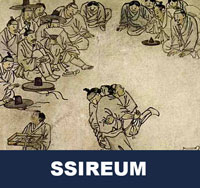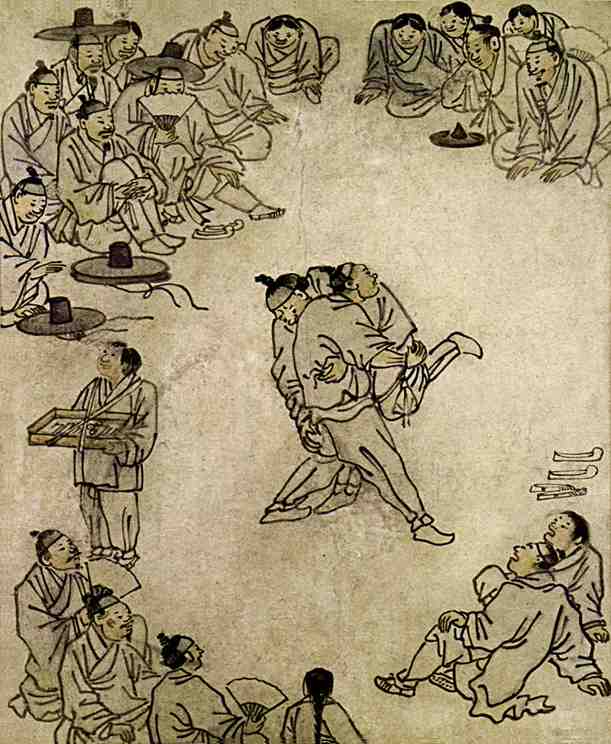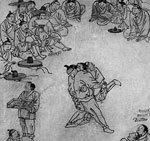Taekwondo 태권도Taekwondo Preschool
Korean martial arts are military practices and methods which have their place in the history of Korea but have been adapted for use by both military and non-military personnel as a method of personal growth or recreation.

About Ssireum 씨름
Ssireum (Hangul: 씨름) or Korean wrestling is a folk wrestling style and traditional national sport of Korea. In the modern form each contestant wears a belt (satba) that wraps around the waist and the thigh. The competition employs a series of techniques, which inflict little harm or injury to the opponent: opponents lock on to each other's belt, and one achieves victory by bringing any part of the opponent's body above the knee to the ground.
Etymology
Historically, with the introduction of Chinese culture, there have been other terms for "wrestling" in Korean used alongside ssireum, such as gakjeo (각저:角抵), gakhui (각희:角戱), gakryeok (각력:角力), gakji (각지:角支), chiuhui (치우희:蚩尤戱), sangbak (상박:相撲), jaenggyo (쟁교:爭交). Gak (각:角), a commonly used prefix, seems to have originated from the combative act performed by horned animals such as oxen when competing against one another for the superiority of physical strength. Korean wrestling was strongly influenced by gaogouli/goguryogi (고구려기:高句麗技).
History
Ssireum first gained widespread popularity during the Joseon Dynasty (1392-1910). Evidence of this is shown through the genre pictures of Kim Hongdo (see the above picture, Sangbak (상박:相撲)). In traditional life, Ssireum was a popular activity on the Korean holiday of Dano, the fifth day of the fifth lunar month, and tournaments are held in the summer and autumn. Ssireum competitions were also held on other days such as the Third Day of the Third Moon, the Eighth day of the Fourth Moon, Buddhist All Souls’ Day, etc. The traditional prize for winning a tournament was an ox, a valuable commodity in agriculturally-oriented society, which symbolized the strength of the contestant.
The modern sport has developed in the 20th century. The first modern competition was held in 1912 at the Dansongsa theater in Seoul. Korean wrestling has been referred to as ssireum since the 1920s. The Pan Chosun Ssireum Federation was founded in 1927. Since 1947 the competition organised by the Ssireum Federation has been called the National Ssireum Championship Contest. Weight classes were introduced at the 12th National Ssireum Championship Contest, and revised in 1967. There are two traditional styles of Ssireum: a "right sided" style predominant in parts of the Gyunggi province, and Honam province of southern Korea, and a "left side" style favoured in Hamgyung province, Gyungsang province and Choonchong province. The difference depended on the way the satba was fastened. In 1994, the Korean Ssireum federation, chaired by Hong sup Kim, proposed the unification of Ssireum in a single style and left sided Ssireum was adopted as the official style to be used by all competitors.
Method of Competition
Ssireum is conducted within a circular ring, measuring approximately 7 meters in diameter, which is covered with mounded sand. The two contestants begin the match by kneeling on the sand in a grappling position (baro japki), each grabbing a belt—known as a satba (샅바)—which is wrapped around his opponent's waist and thigh. The wrestlers then rise while retaining their hold on the other's 'satba.' The match is awarded to the wrestler who forces the other contestant to touch the ground with any part of his body at knee level or higher. Unlike sumo, pushing your opponent outside of the ring does not warrant a win, just a restart. Normally, professional ssireum is contested in a best-out-of-three style match.

There are 3 judges, a chief referee and three sub referees. The chief judge is positioned inside the ring, whereas the sub referees are located on the outside of the ring, one to the right and others to the left. If an unfair judgment is called or the chief referee is unable to render a decision, the sub referees can request a revocation of the decision or a rematch. In addition, they can recommend the cessation of the match when an injury occurs. The referees’ decisions throughout the competition are absolute and held in the highest regard, meaning that athletes cannot challenge any judgments declared during the match.
Today there are also women Ssireum wrestlers. Women wrestle only among themselves but follow the same rules (except that men are topless whereas women wear tops).
There are 4 weight classes in professional wrestling: flyweight (Taebaek), lightweight (Geumgang), middleweight (Halla), and heavyweight (Baekdu), named after the four famous peaks in Korea.
Traditionally Ssireum was contested with the top portion of the trousers rolled down to provide grip. The use of "satba" was invented with the birth of professional Ssireum in the mid-20th century. There is a movement to restore this traditional method of grip, in the spirit of maintaining its cultural and traditional roots, but it has met with some resistance as the use of "satba" has become entrenched in the modern form.
The professional league is dwindling in popularity and many wrestlers have turned their attention to mixed martial arts fighting, even though Ssireum involves no striking or submissions of any kind, as a means of making a living. Choi Hong-man, former champion of Ssireum, is enjoying notable success in the K-1 scene. Unfortunately, the future of professional Ssireum remains bleak, with only one team remaining. However, it can also be argued that Ssireum is beginning to undergo global expansion as a popular martial arts sport, alongside taekwondo and hapkido.
It is important to note the differences between Ssireum and sumo. Ssireum has remained largely a national/traditional sport. Physical hits such as slaps and blows are not permitted in Ssireum, though they are in sumo. In both sports, the competitors are often quite large, though Korean wrestlers tend to be leaner. However, size does not guarantee success in either sport. Although both sports are quite similar, they differ in characteristics as well as values.
The national governing body of the sport in Korea, Korean Ssireum Organization, has made a claim that Ssireum is characterized as a "peaceful competition focusing on harmony and unison", reflecting the "philosophical outlook of the Korean Race".
When you reach senior belt you are expected to guide the junior belts when they are beginning Taekwondo such as showing by example. To advance from one rank to the next, students typically complete promotion tests in which they demonstrate their proficiency in the various aspects of the art before a panel of judges or their teacher. View Taekwondo belt levels »
RESOURCES
This article uses material from the Wikipedia article "Ssireum", which is released under the Creative Commons Attribution-Share-Alike License 3.0.













